Master the Art of Color: Inspiring Palettes for Artists

Key Takeaways
- Blue, red, yellow, and green ground Google's palette, each denoting intelligence, passion, innovation, and growth. Go with official color codes all the way to defend brand clarity at every touchpoint.
- Start with a neutral foundation. Whites, grays and blacks offset bold primaries and aid readability. Save neutrals for backgrounds and text to maintain clean, clutter-free interfaces.
- Distinctive functions for accent and mistake. Set accents for highlights and actions, and maintain error colors separate for warnings. Record these functions to facilitate usability and rapid identification.
- Give the majority of your space over to neutrals, then primaries, then use accents to direct. Develop a proportion chart to keep visual hierarchy consistent across screens.
- Put psychology and accessibility first. Blue not only signals trust, but balances energetic colors like yellow and keeps contrast high for readability. Test palettes for WCAG contrast, colorblind safety, and across devices.
- Purposefully evolve your system. Establish objectives prior to selecting hues, categorize a portable palette, and sample mixes in both still and in-motion. Get your light and dark modes ready and check up on them often to keep things current and inclusive.
💫 Build My Palette
Ready to create your own harmonious color palette with professional design principles? Our palette builder helps you craft stunning color combinations for any project.
Build My Palette →Google's color palette is the official brand colors used throughout Google's products, guided by Material Design. The primary colors are blue (#4285F4), red (#DB4437), yellow (#F4B400) and green (#0F9D58), with light and dark shades for contrast.
Designers employ these hues for definitive UI states, robust accessibility and cohesive brand signals. For clean layouts, combine primary colors with neutral grays, stick to contrast ratios, and align elevation.
The following chapters demonstrate real-world examples.
📚 Recent Articles
Deconstructing the google color palette
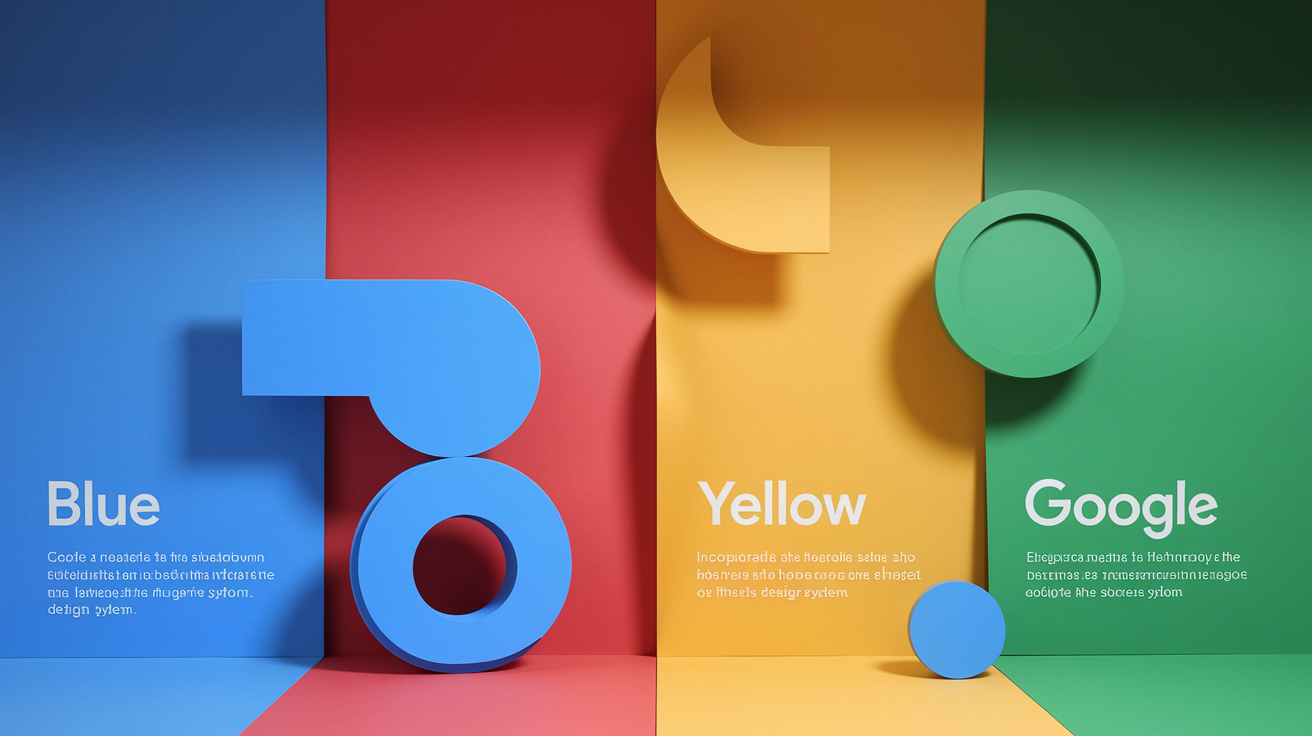
A transparent palette establishes faith and accelerates decisions. Google's core employs four primaries—blue, red, yellow, green—augmented by neutrals and a handful of accents and states. It works because the system codes are specific, the roles are clear and the proportions are the same from product to product.
1. The primary four
Google's foundation is four hues: blue (#4285F4), red (#EA4335), yellow (#FBBC04), and green (#34A853). Together, they show up in logos and icons and UI cues, frequently in a particular proportion with blue as the anchor.
Each color carries a simple idea: blue signals intellect and trust, red hints at strength and energy, yellow leans into creativity and optimism, and green points to growth and progress. Users read these fast, even without realizing it.
Use exact values to keep work aligned across screens and print:
- Blue: HEX #4285F4; RGB 66,133,244; CMYK 73,45,0,0; Pantone 2381 C
- Red: HEX #EA4335; RGB 234,67,53; CMYK 0,82,78,0; Up close, look at a swatch of Google's color palette.
- Yellow: HEX #FBBC04; RGB 251,188,4; CMYK 0,28,97,0; Pantone 1235 C
- Green: HEX #34A853; RGB 52,168,83; CMYK 82,0,94,0; Pantone 7739 C.
Lock these codes into your design tokens. Then repurpose them in buttons, badges, charts and illustrations so the brand voice remains consistent.
2. The neutral foundation
Neutrals — white, gray, black — do the heavy silent lifting. They hold space, create contrast and keep the primaries from yelling.
Google frequently relies on #202124 for high-contrast text and #9AA0A6 for secondary text or icon strokes. White or near white grounds dense screens and makes color cues pop.
Use neutrals for surfaces, content backgrounds and typography. They boost readability and relieve eye strain on extended passages.
When the UI gets colorful, add a neutral layer to reset the eye and restore order.
3. Accent and error
Accent colors are those little sparks that indicate an action, a highlight or selection state. On multiple Google surfaces, blue (#4285F4) serves as a principal accent for links and primary buttons, with subtle tints stretching it for hover and focus.
Error colors are sharper reds designed for alerts and errors. Match a dramatic error red with lighter tints for backgrounds and a deep tone for copy, so visitors scan urgency quick without clutter.
Build a compact set: primary accent, secondary accent, success, warning, error, each with roles and contrast-checked steps.
Save accents separate from mistakes and foundations. For usability, clarity trumps flair every time.
4. The science of proportion
Give most room to neutrals, then to content, then to sparing accents. This keeps pages serene and directs the eye.
Google's ratio oftentimes leans heavy neutral/blue, with red/yellow/green in short hits to indicate state/category or brand rhythm. Charts do likewise to keep sense lucid.
Draw out a rough proportion chart for your palette—percentages for background, text, accents, states—and try it out on a sign-up flow, a dashboard, a settings page.
Color dominance shifts tone. Balance fights fatigue, hones hierarchy and gives the brand a sense of steadiness.
The psychology of choice
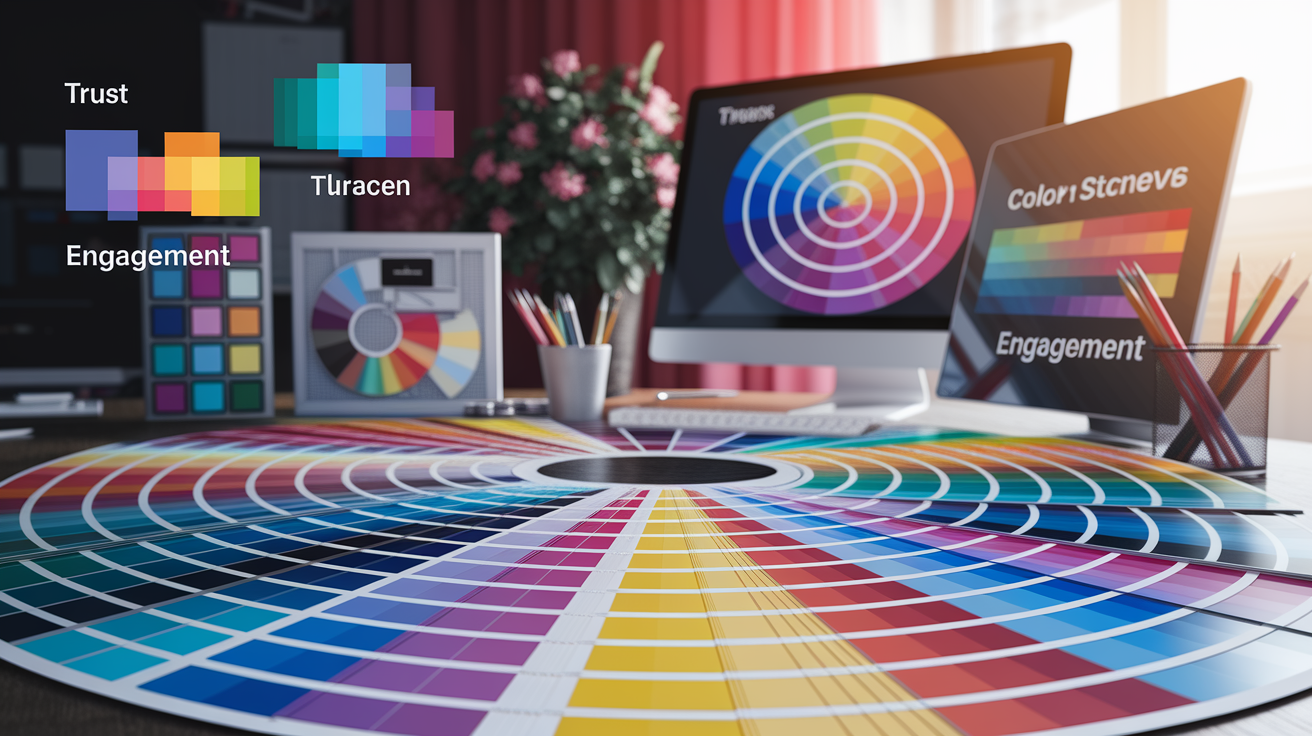
Color directs focus, establishes atmosphere and prompts activity. Google's palette—blue, red, yellow, green—works because each color has different signals that influence how you think and act, particularly with choice overload. When users confront multiple routes, color decreases resistance, directs attention, and facilitates fast, sure decision-making.
Nevertheless, impacts are situation-specific, color psychology is complicated and thrives with thoughtful, real-world experimentation.
Evoking trust
Blue says dependable and serene, which is why Google relies on it for search, links, and system messages that have to seem solid. For decades, research has demonstrated that color has the ability to influence both cognition and emotion — blue, for instance, tends to relax and promote analytical processing, a nice match for endeavors requiring precision.
Place trusted colors where risk feels highest: sign-ins, payments, permissions, account settings. Striking blue in critical UI elements can reduce user apprehension and improve completion, particularly when decisions are high-stakes or social norms encourage wariness.
Steer clear of garish, high-arousal colors in trust-critical flows. Red, for example, can increase arousal and come across as commanding or even aggressive—it can assist with alerts, but it can degrade comfort if employed for main operations in safety-sensitive contexts.
Combine blue with neutral backgrounds and high-contrast, easily readable text so clarity complements trustworthiness.
Sparking creativity
Yellow and other bright tones signal energy and play. Researchers observe that hues like red and yellow may trigger automatic biological responses associated with emotion and behavior. In creative tools, learning hubs, and discovery feeds, a warm accent can incite exploration and alleviate the burden of choice overload by highlighting a next step.
Leverage these shades to illuminate new functionality, onboarding tips, or alternative routes. Keep them off mission-critical controls to avoid mixed messages. One broad brushstroke of bright color is seldom required; a tiny badge or trim will frequently achieve more.
Balance is important. Match creative accents with calmer grays or gentle blues to maintain focus. Rotate accent colors for seasons or campaigns to refresh the feel without retraining users. Keep interaction colors consistent so muscle memory stays intact.
Ensuring clarity
Clarity triumphs when contrast is intense. Shoot for high brightness contrast to make sure your text and icons stand up to screens, glare, and dim lighting. Test pairings on mid-level devices, outside, and with color-blindness simulators.
Use unique, persistent colors for actions, links, and alerts. Red can signify mistake or halt; it cues lust and power, great for emergency alerts and dangerous for everyday CTAs. Context steers significance, and surroundings and conventions color how users interpret a hue.
Build a color hierarchy: primary actions, secondary paths, status states, and passive surfaces. Close to the map, to control choice overload. Competition on red demonstrates dominance with studies of red in competition; in interfaces, save that power for high-stakes cues, not routine taps.
A palette built for everyone
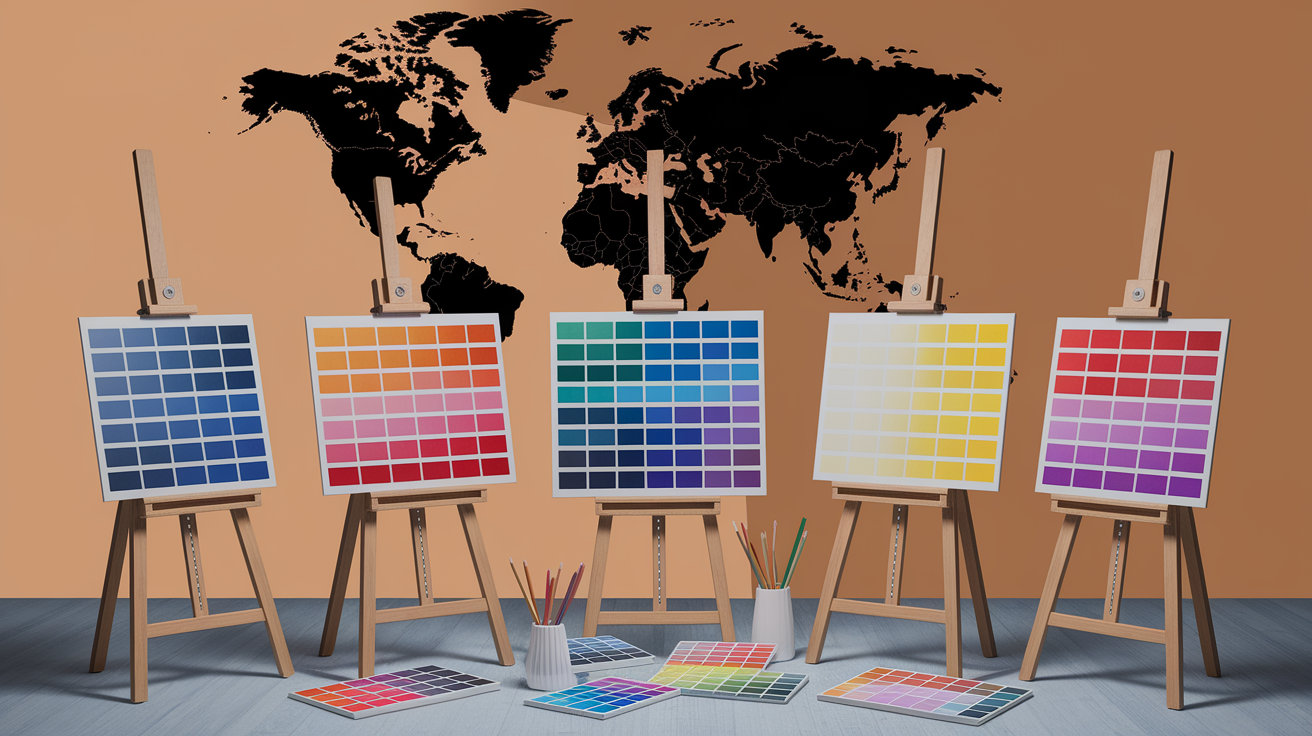
A palette built for everyone helps teams ship universal work. It straddles neutral, emotive and functional, and remains consistent across screens, print and code. Think of it as a base kit: neutrals like #FFFFFF, #000000, and #9AA0A6 for structure; expressive hues like #EA4335, #4285F4, and #34A853 for voice; and values defined in hex, RGB, and CMYK for smooth handoffs.
When executed properly, it resonates for pros and amateurs, across goods and industries.
Global resonance
Choose colors that have good or at least neutral connotations internationally. Blues such as #4285F4 read trustworthy and calm in a lot of contexts. Greens such as #34A853 represent achievement and the outdoors. Warm reds like #EA4335 bring vigor but require caution adjacent to alerts.
Neutrals (#FFFFFF, #000000, #9AA0A6) frame layouts without heavy cultural baggage. Study iconography prior to launch. It can signify luck in East Asia, mourning in parts of South Africa, or warnings in signs everywhere else. White denotes purity in certain societies and bereavement in others.
Yellow might seem celebratory in some parts of Southeast Asia but warning in signs everywhere else in the world. Record your discoveries in a communal playbook, and accompany each color with use cases and 'steer clear' annotations.
| Color | Common associations | Notes for global use |
|---|---|---|
| #4285F4 (Blue) | Trust, tech, calm | Safe for UI actions, links, headers |
| #34A853 (Green) | Success, growth, nature | Use for success states, progress |
| #EA4335 (Red) | Energy, alerts, luck | Reserve for errors or high-emphasis |
| #FBBC05 (Yellow) | Warmth, highlight, caution | Use as accent; mind contrast |
| #9AA0A6 (Gray) | Neutral, structure | Text, borders, disabled states |
Customize accents by region when necessary. Keep the core palette steady, then tweak secondary shades—warmer highlights for holiday pushes, cooler for finance—to satisfy local preferences without compromising brand.
Universal accessibility
Contrast check with WCAG 2.1. Aim for 4.5:1 for body text and 3:1 for large text or icons. Test default, hover, focus and disabled. Adjust grays (#9AA0A6 over #FFFFFF will break body text) and include bold on-color combinations like #000000 over #FFFFFF.
Cater to color-blind users with friendly variants and smart patterns. Don't eschew color as the sole means to communicate state. A green success banner deserves an icon and some text. Error red (#EA4335) would be paired with an error icon and bold label.
- Icons (check, alert, info)
- Labels ("Success," "Error," "Pending")
- Patterns or underlines for emphasis
- Shapes or borders with distinct styles
- Motion cues that don't rely on color
Use tools to preview actual conditions. Simulate deuteranopia and protanopia, test in grayscale and inspect contrast ratios. Verify on phones, giant monitors, dark modes, and printed CMYK proofs to spot problems before they happen.
A solid, device-proof palette lets teams stay consistent while moving fast and provides non-designers a protected route to smart color selections.
Lessons for your artist color palette
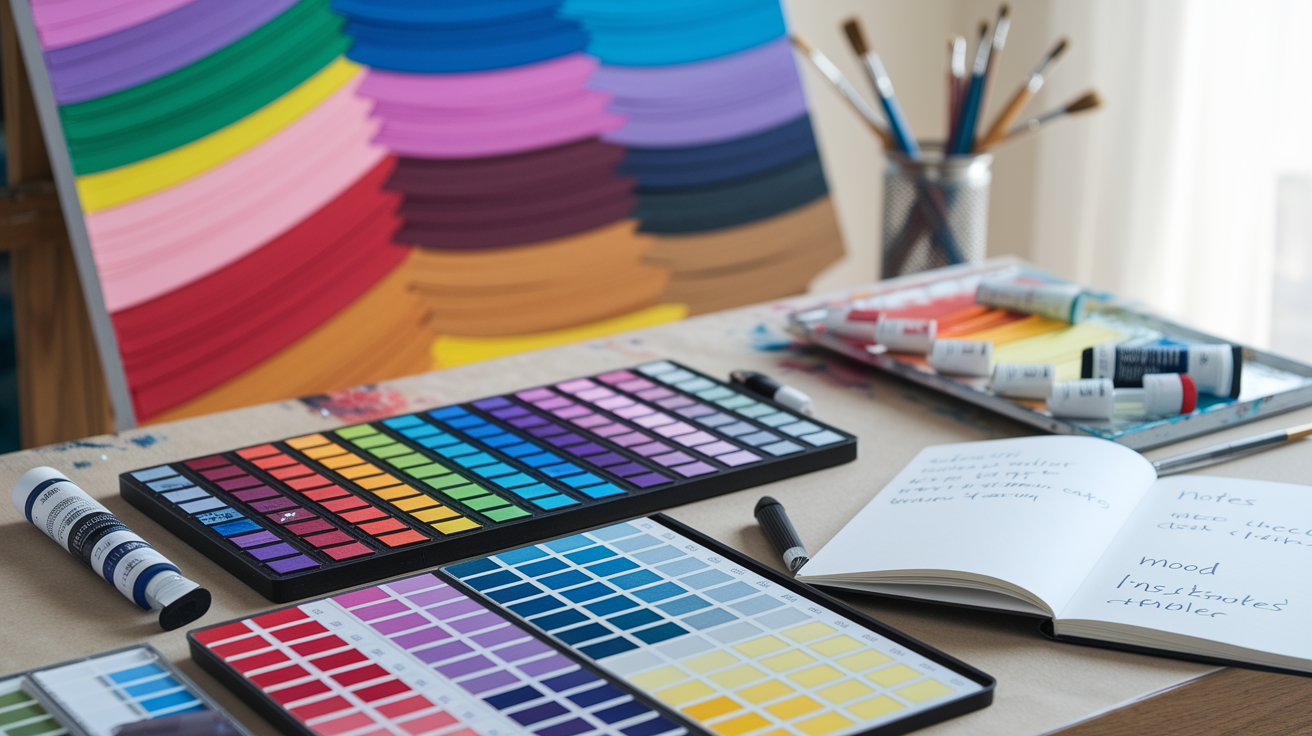
Google's color work illustrates how a transparent system liberates creative energy. Treat color like a toolkit: start with intent, define roles, test for contrast, then keep notes so your work stays steady across pieces and platforms.
Start with purpose
Make the call on the story first. What emotions should the viewer experience—tranquility, immediacy, happiness, gravitas? Jot down the location, the character and the critical moment you want to capture.
Select a single base color that reflects that mood. Maybe a cool blue for trust, a muted green for growth, or a deep red for tension. Then move hue, saturation and lightness to spin tints and shades that remain true to the base.
Construct the remainder of your palette around the message. If your piece is about clarity, select high contrast pairs for points of emphasis and more subtle tints for supporting roles. So keep the fluff to a minimum.
A functional spectrum is 4–6 colors that pair together; it trims the clutter and eases anxiety so you can have fun.
Spend 20 minutes for the first pass. This compels concentration and makes color palette construction a swift warmup rather than an obstacle.
Build a system
Group colors as primary (dominant), secondary (support), accent (callouts) and neutral (backgrounds and text). Assign jobs: primary drives the mood, secondary holds large fields, accent marks actions or highlights, neutral gives rest.
Write guidelines for utilization. For example: accent under 10% area; neutrals for text only; main never less than 70% saturation as a highlight. This sort of constraint accelerates decisions.
Sketch up a swatch panel. In Photoshop, create labeled swatches and a reference board. Use the color picker, then experiment with variations in overlay blending mode to check how the colors layer.
Refresh the guide as your style evolves or a project requires a new feel.
Test for contrast
Test all your key combinations for readability, particularly text on color blocks and tiny icons. Turn a snapshot to grayscale to gauge value clashes—if two regions bleed together, spread them apart!
Fine-tune saturation, brightness or hue until edges pop at a glance. Record winning combos – hex codes, use cases, and scale notes. This practice saves time and creates consistency across monitors, machines and printers where colors can wander.
Try out multiple monitors if possible, and print a tiny proof for catches.
Limit your choices
A tight set generates cohesion, legibility and pace. Try monochrome for tranquil concentration or analogous (neighbors on the wheel) for smooth, gently shifting flow.
- Cap the core set to 4–6 colors.
- Fix one accent for actions only.
- Prefer tints/shades over new hues.
- Repeat ratios across pieces.
- Remove one color if two do the same job.
Review on a monthly basis. Cut what you don't and polish what you do. Employ image boards, by theme, then sample recurring hues to invigorate without fracturing unity.
Adapting your color palette for drawing
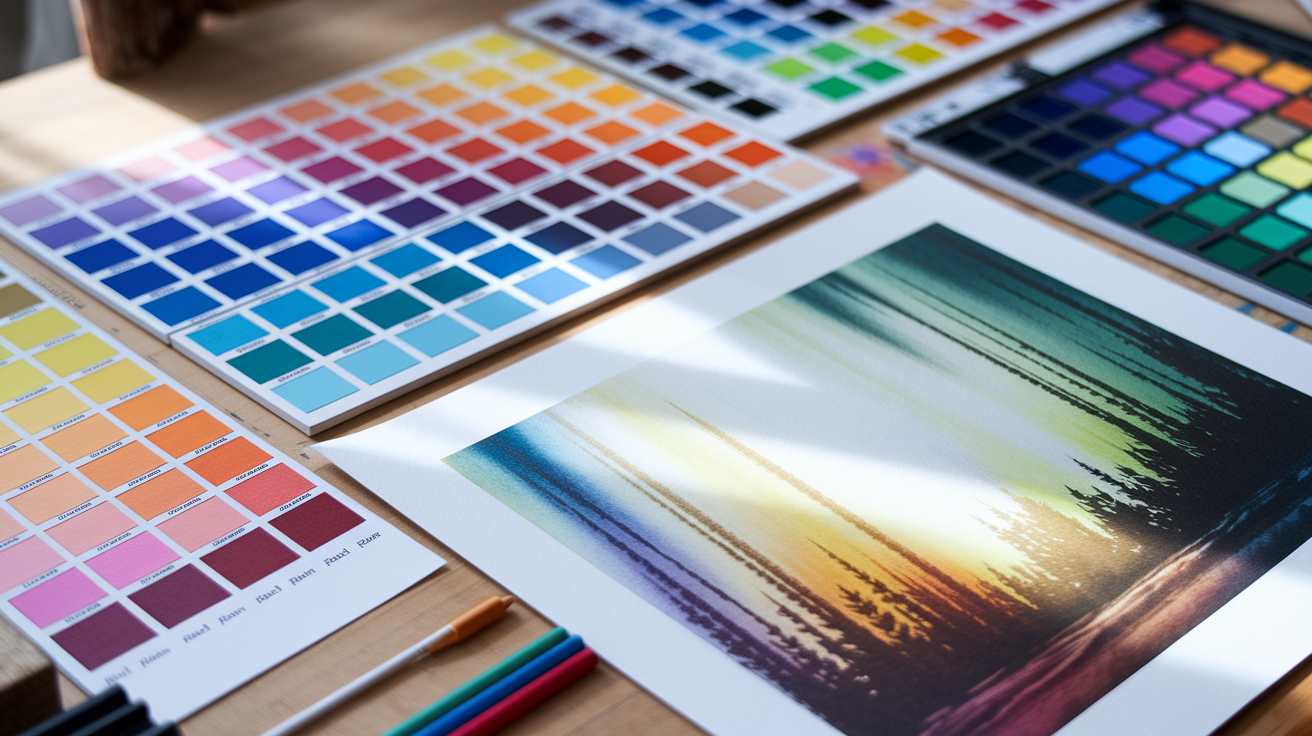
Adjust the Google-inspired color palette to your medium, subject, and mood. Start small: pick 3–4 colors with at least one tint, one regular, and one shade for balance. Start with one base color, then tweak hue, saturation and lightness to produce tints, shades and tones.
A 360° color wheel guides your exploration — wrap around the hue column to test subtle changes. Try swatches first—paper or screen—to test contrast, legibility, blend behavior. Lower opacity to discover soft blends, and observe how warm and cool tones shift in depth.
Defining mood
Mood begins with purpose. If the subject is calm, tip toward cool blues and blue‑greens. For vitality, warm reds and oranges. Think in families—analogous hues calm, split complements bring tension without frenzy.
Darker shades push drama, or mystery, or weight. Pale hues lift scenes toward gladness or expansiveness. A simple way: choose one key hue, then build a tint for highlights and a shade for structure. Keep one neutral to steady the set.
Study known palettes for cues: film stills with teal‑orange contrasts, Impressionist pastels for light, Bauhaus primaries for clarity. Don't rip, crack what so and transcribe it to your drawing.
Temperature counts. Warm foregrounds push forward. Cool backgrounds withdraw. Adapt a color's warmth or coolness with small hue shifts (5–15° on the wheel) rather than large jumps.
Creating focus
Utilize contrast to direct the eye. Match a quiet field with a saturated highlight, or a dark ground with a brilliant focal note. Even minor value jumps can direct attention when hue contrast is low.
Make accents rare. One bright in a 3–4 color set does more work than three competing brights. Color blocking assists in organizing your space.
Relegate one hue family to foreground, another to background, and a neutral bridge to midground. Include a lighter tint edge highlight to delineate forms without heavy lines.
Vary saturation and lightness along a trail. Step from low‑sat midtones to a high‑sat highlight, then fall down on a calmer shade to refresh the eye. Fade opacity until edges seem clean but not aggressive.
Harmonizing elements
Unity derives from relationship. Select analogous tones—for example, blue, blue‑green, and green—and complement them with one neutral gray to keep things grounded. Maintain the palette small so each stroke connects.
When mixing complements, do so slowly. Always pull a darker hue for shades, a lighter one for tints, and double-check swatches adjacent to each other to prevent muddy overlap.
Now divide the spectrum into thirds on the 360° wheel. From every third, adjust saturation and lightness to cultivate a tint, a normal, and a shade. This produces cohesion along with variety.
Employ instruments. A color picker accelerates experiments, and test spots show you how watercolor granulates, pencils layer or digital brushes mingle.
The palette beyond the static
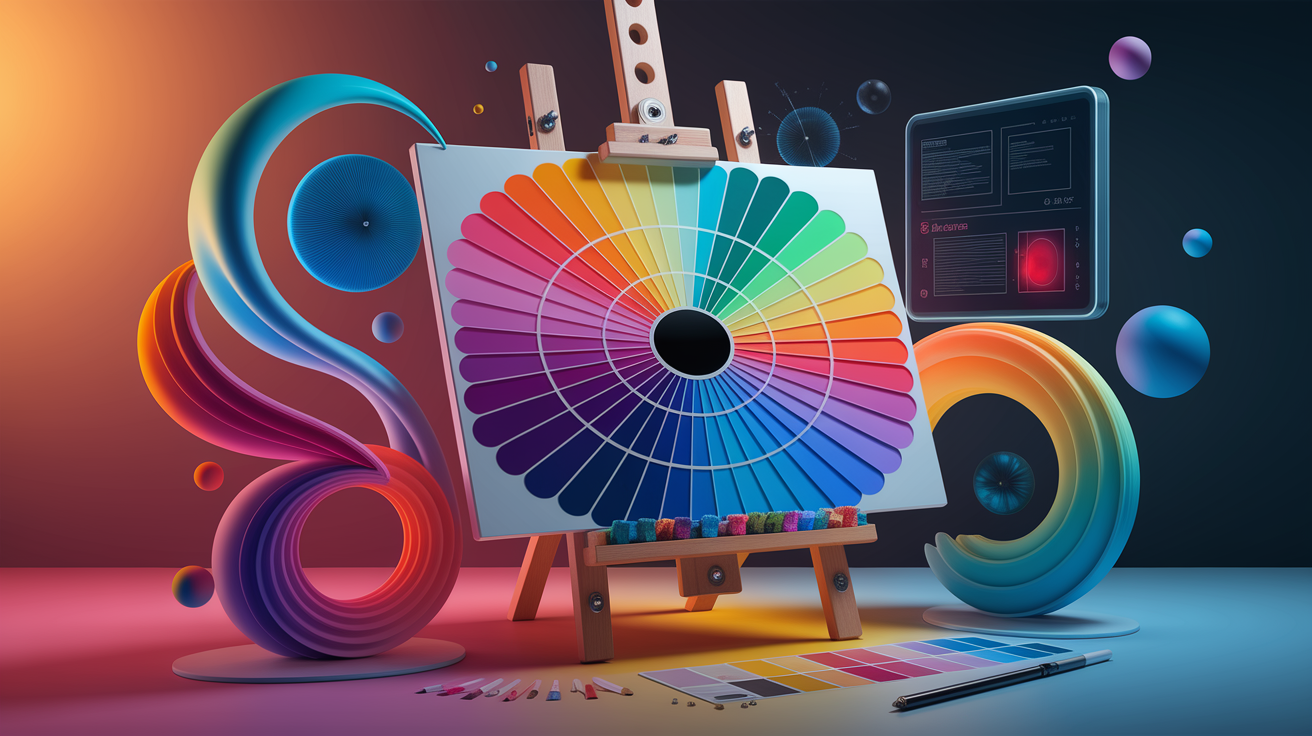
Color selections must function in live environments where screens scroll, layouts bend and movement communicates. A steadfast palette guards visual identity across devices, yet still allows for local nuance and variation.
Color in motion
Design for how color appears in motion. Test buttons that scale, chips that slide, charts that animate. Watch for flicker, banding and weird blends on mid-range displays.
Color speaks volumes than copy in motion, so subtle shifts are more important than you think. Maintain contrast in transitions. If a card fades from 20 to 0 opacity, ensure text still bests WCAG ratios.
Stay away from color pairs that vibrate when you move, like pure red against pure blue. Geometric sans-serif assists here as well — it scales better, animates smoother, and reads crisper over motion.
Use motion to direct behavior and build a brand. A primary with a dash of a twist— a bit warmer red, more purpler blue—can signal identity as they shift.
One team discovered that a purpler blue tested better in A/B tests across video bumpers and GIF loops. Colors both stir up feeling and ignite tapping, so gauge increases in hover dwell time, play rate and tap targets.
For video and GIFs, preview on different frame rates and compression levels. Highly saturated colors will clip with heavy compression, so construct export-safe shadows.
Test subtitles against brand backgrounds, and keep backgrounds below 40% luminance for readable type.
Light and dark modes
Design double palettes, not opposites. Map roles first (background, surface, primary, success, warning), then adjust values to maintain contrast and tone consistent across modes.
Test accessibility on actual views, not swatches. Shadows in dark mode usually require color tints, not alpha. In light mode, mute chroma on large surfaces to minimize glare.
Record policies for auto-switch, user override, and hybrid states. Outline least contrast, elevation tokens, and how images/icons re-tint in each theme.
Future-proofing color
Screens vary, tastes vary, renderers vary. Design for HDR, wide-gamut displays and low-power modes. Specify base tints in perceptual colorspaces and maintain hex, HSL, and OKLCH equivalents.
Check the palette on a regular cadence and A/B test high-impact spots. Measure engagement and conversion lifts associated with color tweaks across product lines.
Invent a scalable system with roles and tokens so new features can plug in. Store away old palettes in context and learnings to guide the next round.
Conclusion
The Google color palette exhibits obvious rules that continue to leave space for playing. Bright primaries provide a bold foundation. Neat colors preserve readability. Smart contrast guides your eye. That combination makes it easier for broad audiences to read, skim and respond.
To experiment with concepts, take tiny strides. Switch one color. Nudge a hue by 10%. Verify light and dark modes. Run quick checks for contrast at 4.5:1 or more. See how a red button blabs beside a blue link. Observe how a warm yellow brings bod and lift to a dead screen.
To develop proficiency begin with a close group. Keep names small. Monitor use with an easy grid. Need a hand or a second eye? Send me your tentative palette, and I can take a look.
Frequently Asked Questions
What is the Google color palette?
Google's palette features bold, primary-based hues: blue, red, yellow, and green, with precise tints and shades. It's a nice balance of high contrast and approachability. These colors are optimized for readability, accessibility and brand recognition across screens and environments.
Why did Google choose these specific colors?
The colors communicate transparency, reliability and energy. Blue implies trustworthy, red infuses an excitement, yellow is welcoming and warm, and green is growth. Together, they bring balance and inclusivity. The palette tests well for accessibility and visibility at smaller sizes.
How does the palette support accessibility?
Google's colors satisfy contrast guidelines when paired appropriately. It has tints and shades for readability on light or dark backgrounds. Regular application increases recognizability for low-vision or colorblind users. Test contrast ratios, always.
What can artists learn from the Google palette?
Restrict your palate to some strong colors. Assign specific functions to each color. Use contrast to direct focus. Add tints and shades for dimension. Be consistent across formats. It accelerates decisions and increases coherence in sketches.
How do I adapt a palette for drawing?
Begin with three to five primary colors. Make tints (white added) and shades (black added) for value control. Experiment with colors in various lighting. Test contrast for points of interest. Maintain a swatch sheet to remain consistent from page to page or frame to frame.
Can the palette work beyond static images?
Yes. Use motion, scale and contrast to reinforce hierarchy in animations or UI states. Adjust brightness (hover, focus, error). Keep colors consistent between devices. Write usage rules to make conversations manageable and open.
How do I balance brand colors with user needs?
Focus on readability and contrast first. Use brand hues for accents, not giant text blocks. Give neutral backgrounds. Test with real users including color blind users. Iterate on data, not taste. This fosters confidence and transparency.